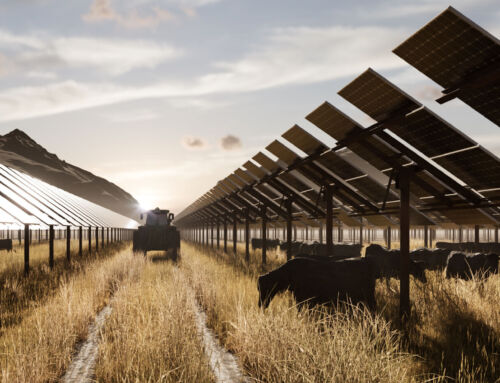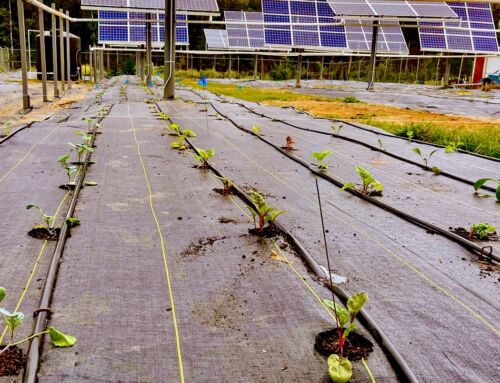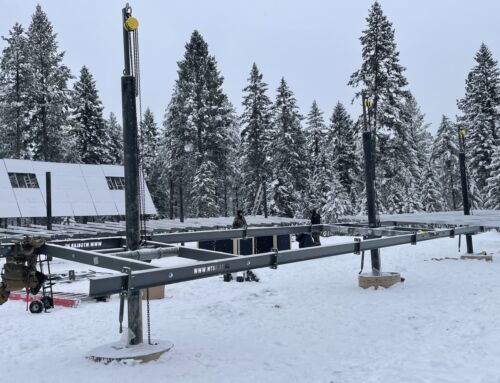Maximizing a mount’s energy output is part of gaining a return on your solar investment. That’s why it’s so important to keep the solar array in an optimal position. Solar trackers do this by shifting in the mount’s tilt through manual or automatic controls.
All MT Solar pole mounts include a manual tilt adjuster. It’s a built-in feature that allows for changes in the position of the solar array using a crank handle or power tool. It’s a standard example of a manual solar tracker.
But what about automatic solar trackers? These systems get a lot of attention for their ability to alter the position of a solar array in direct response to light, temperature, or according to a preset schedule. They vary in function, price, and performance, but their main advantage is improving solar output by making mounts more responsive to the daily path of the sun.
Just how do they compare to manual solar trackers? Are they the best way to maximize solar energy production and gain returns on a mount investment? This article will explore the details and differences between automatic and manual solar trackers.
Manual Solar Trackers
Manual solar trackers are mechanical, manually operated systems that move the mount’s frame and solar array across a single axis. They use crank handles and similar tools to make incremental changes to the mount’s angle.

Pros:
Manual solar trackers are significantly less expensive than automated systems. They do not draw energy from the mount or require power storage. All components used in these systems offer longevity that’s comparable with all other mount hardware, which means they do not require component replacement as part of regular maintenance.
They can be easily and quickly adjusted by hand for monthly and seasonal adjustments, ground maintenance like mowing, clearing snow, fallen leaves, pollen, dust, and debris from the array, and as needed without any complicated tools or equipment.
Cons:
Although they can adjust the mount so the solar array is roughly aligned with the daily path of the sun, they’re more effective for making monthly or seasonal adjustments that keep the mount in the best position for sun exposure that’s broad and consistent.
Automatic Solar Trackers
Automatic solar trackers use motors, actuators, or hydraulics to automatically control the position of the array or individual PV modules. They include a variety of different types:
- Active Solar Trackers – Active trackers use light sensors to face the sun’s rays in real-time. They’re used in single and dual-axis systems to provide highly accurate array positioning. These systems draw energy from the array and require power storage to power sensors and motion control components. Some systems include additional real-time features that flatten the array if high winds are detected.
- Passive Solar Trackers – Passive trackers use gas or liquid hydraulic systems that respond to heat. As the daytime temperature increases, the gas or liquid expands and drives a piston that keeps the array moving in the direction of the sun’s warmth. They are not as accurate as sensor-driven or scheduled systems, but they do not draw power from the array and are somewhat simpler than trackers with electronic components.
- Timed Solar Trackers – Timed trackers alter the position of the array based on a programmed schedule. The daily positioning is meant to align with the path of the sun. Unlike active solar trackers, they do not use real-time sensors and are slightly less complex and expensive, but they aren’t as accurate. Timed trackers are electronic-based systems that draw power from the mount and may require separate power storage.
- Azimuth Solar Trackers – Azimuth trackers are similar to timed trackers, but instead of following a timed schedule, they use algorithms to determine the position of the sun in the sky for a specific date and time. Also like timed trackers, they do not rely on real-time sensors, but they still need power to function.
Solar mounts with automatic solar trackers.
Automatic Solar Trackers Pros and Cons
The advantages and disadvantages of automatic solar trackers vary from type to type, but compared to manual solar trackers, there are a few general pros and cons that come with these systems.
Pros:
The main benefit of automatic solar trackers is increasing energy production by keeping the array in an optimal position. Depending on the accuracy of their positioning, they can increase output by 20 percent or greater. This boost is especially impactful in settings where space is restricted and array sizes need to be limited. If budget and maintenance requirements are not significant concerns, automatic solar trackers can eliminate the need to make monthly or seasonal tilt adjustments by hand.
Cons:
Automatic solar trackers can increase the cost of a solar mount installation considerably, costing an additional $500 to $1000 per module or more depending on the features and complexity of the system. Trackers also increase the maintenance cost of solar mounts. Depending on the system, parts will likely need to be replaced or serviced, as motors, sensors, and other tracking components often do not last as long as PV modules and the overall lifespan of the mount.
Due to weight constraints, automatic solar trackers can impose limits on the size and configuration of the array. They can also limit ground clearance and customization options, especially if they are a standard part of the mount.
Cold and frost can also inhibit the function of sensors, motors, and hydraulics, which makes these systems less reliable in colder regions or winter extremes. Some automatic features, such as automated array flattening during high winds, will move the array out of optimal positioning. Resilience against winds can be better gained through the proper mount foundation and hardware.
Options for Maximizing Solar Output Without an Automatic Tracker
Maximizing solar output is one of the leading advantages that automatic trackers offer over manual options. But, there are ways to gain this advantage without the additional expense and management requirements of an automated system.
In recent decades, cost-per-watt amounts for solar energy projects were significantly higher. This was mainly due to the higher price and limited efficiency of PV modules. Solar trackers were developed as an efficiency-boosting solution when solar costs-per-watt rates were at their peak. For a long time, adding more modules to boost output just didn’t make economic sense compared to the addition of an automatic tracker. Even today, automatic trackers can be a justifiable investment if increasing the size of the array is not an option.
But, if array sizes or configurations aren’t strictly limited, a few additional PV modules can be a better way to gain the same 30 percent energy boost that’s also offered by automatic solar trackers. Solar cost-per-watt rates for all types of systems have dropped significantly.
Lower prices and improved efficiency of modern PV modules have made them a more productive and reliable investment compared to automatic solar trackers, especially when accounting for initial costs, ongoing upkeep, and system vulnerability and complexity.
Manually adjusting the mount to a latitudinal-specific tilt for each season is one of the most reliable ways to maximize the productivity and ongoing returns on a solar mount investment–without any costly or inconvenient extra maintenance. For these and other reasons, all of our pole mounts include a manual solar tracker as a standard feature.
Want to increase solar array output?
Here’s why adding more modules makes sense.
Solar tracking technology was developed in 1975¹ when PV module cost per watt was $125.83. Today that price has dropped to $0.26.²
Between 2010 and 2020 PV module prices have decreased by 85%.³
NREL research data show photovoltaic efficiency improvements ranging from 13% to almost 48% between 1976 and today.4
- Sun Tracking Systems: A Review. Sensors (Basel) via PubMed Central, National Library of Medicine. https://www.ncbi.nlm.nih.gov/pmc/articles/PMC3297124/
- Solar photovoltaic module price. Our World in Data. https://ourworldindata.org/grapher/solar-pv-prices
- Documenting a Decade of Cost Declines for PV Systems.The National Renewable Energy Laboratory. https://www.nrel.gov/news/program/2021/documenting-a-decade-of-cost-declines-for-pv-systems.html
- Best Research-Cell Efficiency Chart. The National Renewable Energy Laboratory. https://www.nrel.gov/pv/cell-efficiency.html






